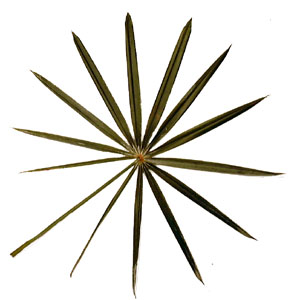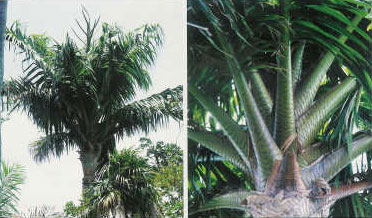The Palm Program

The palm family is an economically important pantropical plant family, second only to grasses (grains) in importance to the lives of people. Many palms are endangered in the wild, largely because of habitat destruction. Difficult to study because of their large size and great diversity of species, palms present many unanswered questions in the areas of systematics, evolution, structural biology and reproductive biology.
The Palm Program exists to understand and document palm diversity.
On-going projects include:
- Revising the classification of the palm family by contributing to a second edition of Genera Palmarum.
- Monographs of selected genera, especially those occurring in the Caribbean. [Sabal, Roystonea, Calyptronoma, Coccothrinax]
- A monograph of Sabal by Scott Zona (1990) [51 MB PDF file - please be patient!]
- A second edition of "Anatomy of the Monocotyledons (Vol. II Palmae)" based on new evidence in relation to the phylogeny of Arecaceae.
- Studying the biology of palm roots, especially in regard to relationships with beneficial fungi (mycorrhizae).
- Molecular phylogenetic studies of horticulturally and ecologically important genera. [Sabal, Phoenix, Ptychosperma, Coccothrinax, Thrinax, Veitchia, Pritchardia, Dictyosperma]
- Population-level studies of ecological and genetic differentiation. [Geonoma macrostachys complex, Dictyosperma]
The Palm Program promotes the conservation of palm diversity.
On-going projects include:
- Assessment of genetic diversity in wild versus ex situ collections of threatened species of palms. [Coccothrinax, Pseudophoenix, Dictyosperma]
- Development of management plans for ex situ collections to prevent interspecific hybridization.
- Development of in-country conservation initiatives.
- Assessing conservation status of palms and producing IUCN Red Lists.
The Palm Program promotes education and awareness about palm diversity.
On-going projects include:
- Discovering palms new to science.
- Dissemination of palm information through scholarly and popular publications in diverse media, including print, electronic and the world wide web. See Fairchild Guide to Palms, an on-line guide to Fairchild's collections and culture of palms in South Florida.
- Expanding the palette of cultivated palms through new introductions and germplasm releases.
- Establishment of the world’s largest collection of palm genetic material, the Tropical Plant DNA Bank, a collaborative project between FTBG and FIU.
The Palm Program builds capacity for the conservation of palm diversity.
On-going projects include:
- Through its Graduate Studies Program, FTBG is training the next generation of palm biologists.
- Establishing on-line resources and expert systems for identifying palms in the Caribbean through non-technical keys, illustrations and maps.
- Conducting training courses and developing reference materials on palm conservation.
